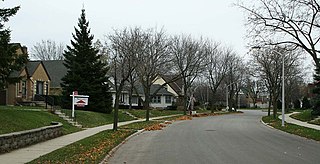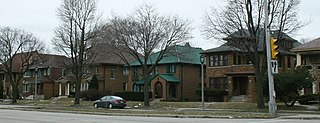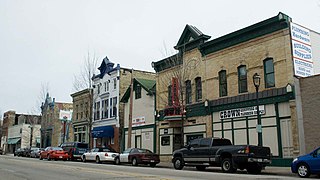
The Historic Third Ward is a historic warehouse district located in downtown Milwaukee, Wisconsin. This Milwaukee neighborhood is listed on the National Register of Historic Places. Today, the Third Ward is home to over 450 businesses and maintains a strong position within the retail and professional service community in Milwaukee as a showcase of a mixed-use district. The neighborhood's renaissance is anchored by many specialty shops, restaurants, art galleries and theatre groups, creative businesses and condos. It is home to the Milwaukee Institute of Art and Design (MIAD), and the Broadway Theatre Center. The Ward is adjacent to the Henry Maier Festival Park, home to Summerfest. The neighborhood is bounded by the Milwaukee River to the west and south, E. Clybourn Street to the north, and Lake Michigan to the east.

Bay View is a neighborhood in Milwaukee, Wisconsin, United States, North America on the shores of Lake Michigan, south of the downtown area and north of the City of St. Francis. Bay View existed as an independent village for eight years, from 1879 to 1887.

The neighborhoods of Milwaukee include a number of areas in southeastern Wisconsin within the state's largest city at nearly 600,000 residents.

The Pabst Brewery Complex, on a hill northwest of the downtown of Milwaukee, Wisconsin, is the former brewery of the Pabst Brewing Company, where the company innovated to improve their beer and increase production until in 1892 it was the largest brewer of lager in the world. In 2003 the complex was listed on the National Register of Historic Places.

The Main Street Historic District in Fort Atkinson, Wisconsin, United States, was placed on the National Register of Historic Places in 1984. The district is composed of 51 buildings on or within a block of Main Street.

Washington Avenue Historic District is the historic center of Cedarburg, Wisconsin, the location of the early industry and commerce that was key to the community's development. The historic district was listed on the National Register of Historic Places (NRHP) in 1986.

The Crescent Warehouse Historic District is a 10.5-acre (4.2 ha) historic district in Downtown Davenport, Iowa, United States. The district is a collection of multi-story brick structures that formerly housed warehouses and factories. Most of the buildings have been converted into loft apartments. The district was listed on the National Register of Historic Places in 2003.

The Badger State Shoe Company is a classically-styled 6-story shoe factory built in 1910 in Madison, Wisconsin, a half mile north-east of the Capitol. It was added to the National Register of Historic Places on April 11, 1989.

The Stoughton Main Street Commercial Historic District is a collection of 36 surviving historic business structures in the old downtown of Stoughton, Wisconsin, United States. It was added to the National Register of Historic Places in 1982.

The Juneau Highlands Residential Historic District is a historic neighborhood in West Allis, Wisconsin, with contributing homes built from 1928 to 1952. It was added to the National Register of Historic Places in 2011.

The East Brady Street Historic District is located in Milwaukee, Wisconsin. It was added to the National Register of Historic Places in 1990.

The North Grant Boulevard Historic District is a neighborhood of stylish houses built on large lots from 1913 to 1931 in Milwaukee, Wisconsin, United States. It was added to the National Register of Historic Places in 1995.

The North Sherman Boulevard Historic District is a largely intact neighborhood of stylish homes built from 1907 to 1955 in Milwaukee, Wisconsin. It was added to the National Register of Historic Places in 2004.

The Milwaukee Athletic Club, is a private, social and full-service athletic club.
Sidney G. Courteen (1864–1945) was an American wholesale seed merchant of British descent.

The Main Street Historic District is a cluster of historic buildings around the intersection of Main Street and Appleton Avenue in Menomonee Falls, Wisconsin. It was added to the National Register of Historic Places in 1988.

The Mazomanie Downtown Historic District is the old downtown of Mazomanie, Wisconsin, with surviving structures built as early as 1857. It was added to the State and the National Register of Historic Places in 1992.

The North Third Street Historic District is a somewhat intact business district on the near north side of Milwaukee, Wisconsin, with a wide range of surviving buildings going all the way back to 1854. It was listed on the National Register of Historic Places in 1984 and on the State Register of Historic Places in 1989.

The Old World Third Street Historic District is the last relatively intact part of the original German retail district in Milwaukee, Wisconsin's Kilbourntown plat, containing examples of various styles of Victorian commercial architecture going back to 1855. It was listed on the National Register of Historic Places in 1987 and on the State Register of Historic Places in 1989.

The Lindemann and Hoverson Company Showroom and Warehouse is a historic industrial building at 2620 W. Washington Boulevard in the East Garfield Park neighborhood of Chicago, Illinois. The Lindemann and Hoverson Company, which manufactured heaters, stoves, and electric kitchen tools, built the building in 1924. Architect Paul Gerhardt, Sr., designed the industrial loft; while such buildings were often plain structures, his design is more formal and includes ornamentation. The building's showroom section, which encompasses the first two floors on the west side, is clad with a terra cotta section which features pilasters and a frieze. The remainder of the building has a brick exterior, though it includes terra cotta medallions and a cornice. Lindemann and Hoverson occupied the building until 1941.



















